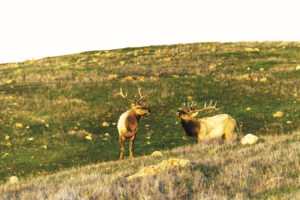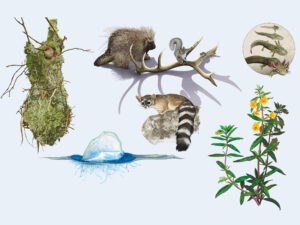The 19th-century cattle baron Henry Miller (not the noted California author of the same name), who once had an estate on Mount Madonna (the subject of our July-September 2007 On the Trail feature) is not generally remembered for his conservation efforts. In fact, he was at the forefront of the endeavor to drain and plow the San Joaquin Valley, where he owned vast stretches of land.
But in the process of that “reclamation” work, Miller did develop a nostalgia for the valley he was working to transform, and that nostalgia may have been the saving grace for dwindling populations of tule elk, the subspecies of elk that once ranged from north of Red Bluff down to the southern Central Valley.
Miller first saw tule elk in the early 1850s as he surveyed the San Joaquin basin for ranchland. Already the elk population was in rapid decline: Competition with horses, cattle, and farmers had pushed them out of the choicest grasslands, and market hunting for the hide and tallow trade further drove down their numbers.
The Gold Rush all but sealed their doom as an exponentially expanding human population sought meat from wherever it could be obtained. Tule elk are the smallest subspecies of elk, but at an average of 400 to 500 pounds each, they still made appealing targets for hungry Forty-Niners. An 1854 law limiting elk hunting in several counties did little to arrest their decline, and when elk hunting was banned outright in California in 1873, many people believed the tule elk had vanished altogether.
And so it was that in 1874, when Miller’s workers discovered a lone pair in a swath of marsh they were draining, he gave instructions that the animals be spared. His men continued to drain the marshes and discover more elk: In 1895 there were 28 known remaining elk, most on Miller’s land, down from an estimated half-million in pre-European California. Over the remaining two decades of his life, Miller continued to protect them, and the elk soon numbered in the hundreds. Such a sizable herd quickly began to wreak havoc on nearby farms, and it was this damage as much a spirit of preservation that drove Miller to ship the elk all over California. Of the herds that Miller established, two remain today, one at Cache Creek (east of Clear Lake) and another in Owens Valley (in Fresno and Tulare counties).
People often point to the tule elk, which today number about 4,000 in more than 20 herds, as a conservation success story, inasmuch as retaining less than one percent of a population can be counted a success. Competition for habitat is a major hurdle. Lake Tulare, so called for the same tall marshland sedge that gave tule elk their name, is long since drained. Much of the elks’ former range has continued to be co-opted for agriculture and housing, the very forces that so diminished their numbers in Miller’s day. When ten tule elk were introduced to Point Reyes National Seashore in 1978, they were kept bottled up behind a fence on Tomales Point to avoid drawing the ire of local dairy operations. A census of the Point Reyes herd taken in early 2007 counted 518 individuals.
Several years ago a small group from the Tomales Point herd was transplanted a few miles farther south within the park, and nearly 50 elk now graze the hills between Drake’s Estero and Limantour. Park service personnel are closely monitoring this smaller herd on the “human side” of the fence; their current range brings them within a few miles of private property.
Well over a century after Miller decided to protect the remnants of California’s once-vast elk herds, the struggle remains between cattlemen, human settlement, and a small number of thoroughly managed elk. At Point Reyes, as at every other elk preserve in the state, both sides of the fence turn out to be the “human side” of the fence.
Further reading on tule elk and Henry Miller:
Bay Nature feature: Where the Elk and the Antelope Played (Vol.4, No.1)
by David Rains Wallace
For more information on the history of the tule elk’s recovery:
www.parks.ca.gov/pages/584/files/TuleElk2004.pdf (220k PDF, requires Adobe Acrobat)
The National Park Service’s page on tule elk: www.nps.gov/pore/naturescience/tule_elk.htm
Tule elk in Point Reyes: www.tomalesbay.net/wildlife_elk.html
For a semi-academic survey of Henry Miller’s role in the transformation of California, check out Industrial Cowboys, by environmental historian David Igler.

.jpg)



